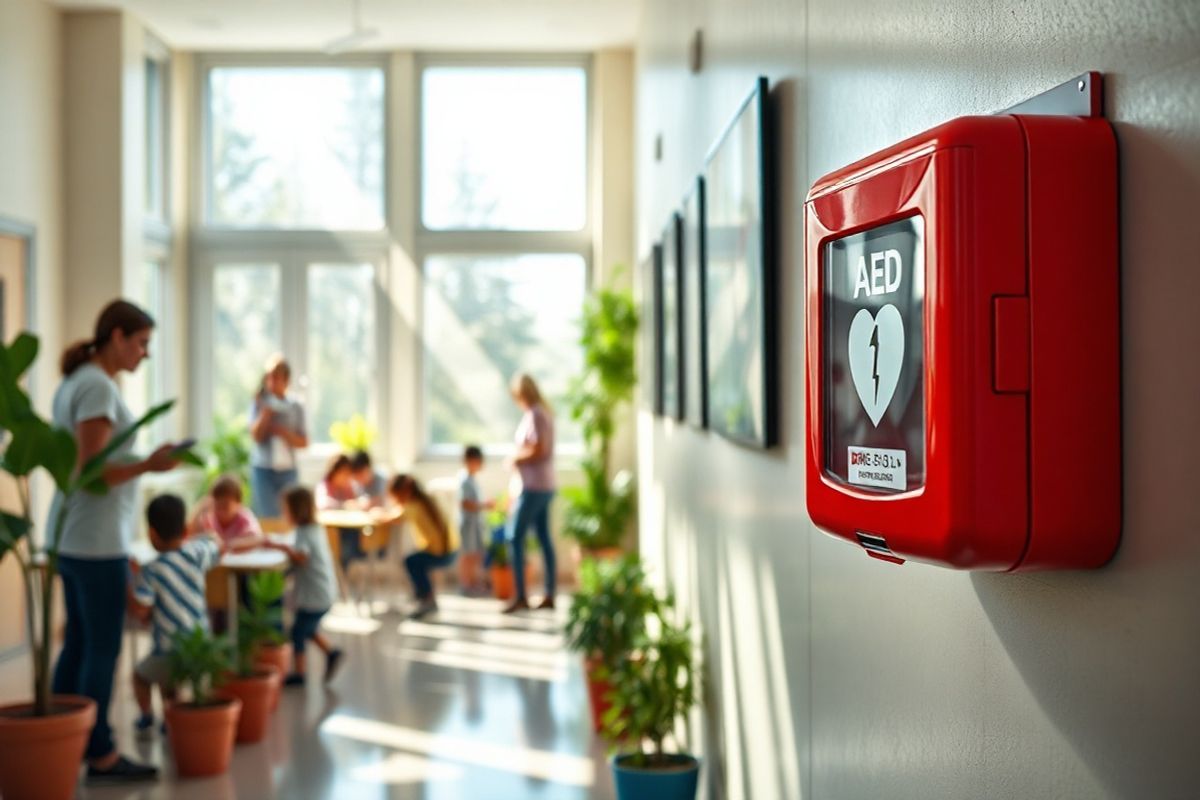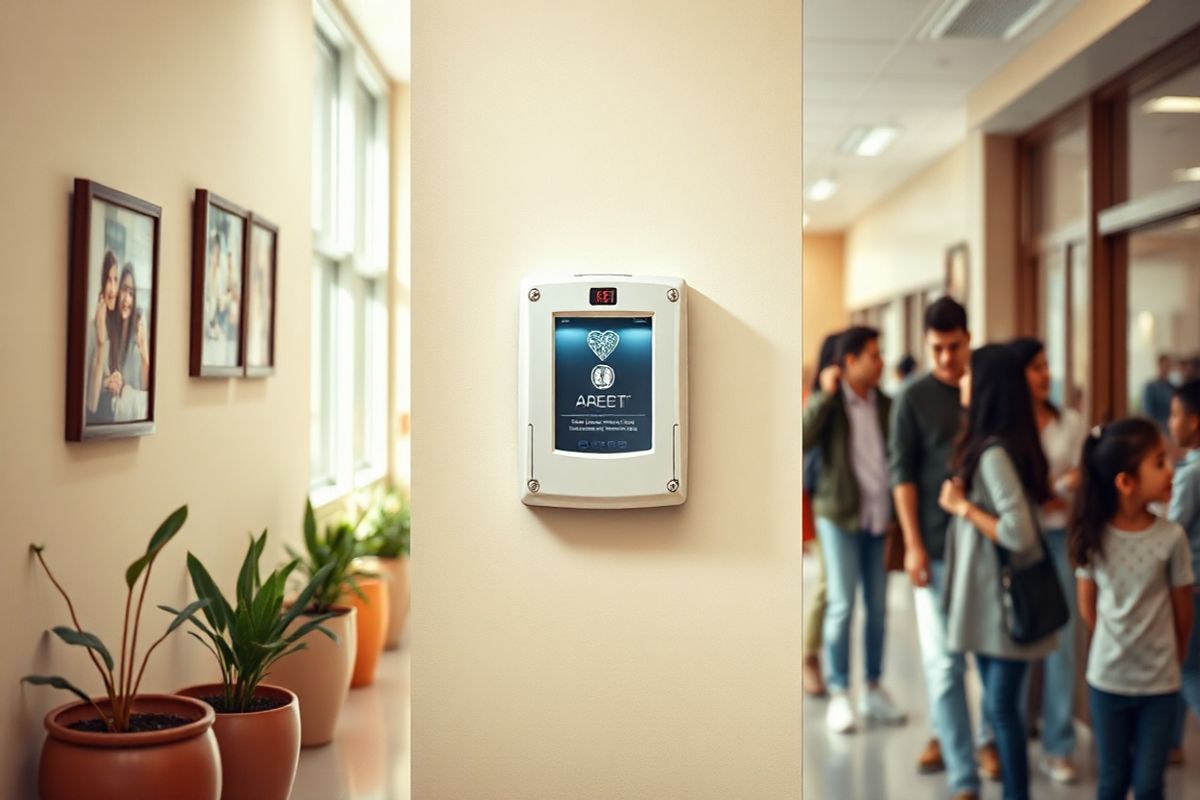Table of Contents
Understanding the Importance of AEDs in cardiac Emergencies

Automated External Defibrillators (AEDs) play a pivotal role in emergency medical situations, particularly during instances of sudden cardiac arrest. Sudden cardiac arrest is a critical condition that occurs when the heart unexpectedly stops beating, leading to an immediate cessation of blood flow to vital organs. The importance of AEDs lies in their ability to deliver an electric shock to the heart, potentially restoring its normal rhythm. In fact, research indicates that more than 350,000 people in the United States suffer from cardiac arrest each year, and the only effective way to restore a regular heartbeat is through the use of an AED (Red Cross, n.d.).
Given that the average response time for emergency medical services is approximately 8-12 minutes, the use of an AED can significantly enhance the chances of survival. Statistically, for every minute that passes without defibrillation, the likelihood of survival decreases by about 10% (Red Cross, n.d.). This emphasizes the necessity for public awareness and accessibility of AEDs in community settings, such as offices, schools, and public buildings, where large groups of people may gather.
Key Steps to Effectively Use an AED During Cardiac Arrest

Using an AED can seem daunting, especially in high-pressure situations; however, these devices are designed to be user-friendly. Here are the essential steps to follow when using an AED:
-
Call for Help: Before using the AED, call emergency services or ask someone else to do so.
-
Check Responsiveness: Ensure the person is unresponsive and not breathing. If they do not respond, proceed with AED use.
-
Turn on the AED: Open the AED case and turn on the device. Most AEDs will provide audio and visual prompts to guide you through the process.
-
Attach the Electrodes: Expose the person’s chest and attach the electrodes according to the diagram on the pads. One pad goes on the upper right chest, and the other goes on the lower left side.
-
Analyze the Heart Rhythm: Ensure no one is touching the person while the AED analyzes the heart rhythm. The device will determine if a shock is needed.
-
Deliver a Shock: If the AED advises a shock, ensure that everyone is clear of the person and press the shock button. The AED will deliver the shock.
-
Continue CPR: After administering the shock, immediately resume CPR. Perform 30 chest compressions followed by 2 rescue breaths. Continue this cycle until emergency responders arrive or the person shows signs of life.
-
Continue to Follow AED Prompts: If the AED prompts for another analysis, repeat the process as necessary.
It is critical to undergo training in AED use and CPR to effectively respond to emergencies. Organizations like the Red Cross offer various training courses that provide hands-on experience and certification (Red Cross, n.d.).
Common Questions About AEDs: Myths and Facts
Many myths surround the use of AEDs that can hinder effective response during emergencies. Here are some common misconceptions clarified:
-
Myth: AEDs are complicated to use.
- Fact: AEDs are designed for ease of use. They provide step-by-step audio and visual instructions, making them accessible even for untrained bystanders.
-
Myth: You can hurt someone by using an AED.
- Fact: AEDs are equipped with safety features that prevent accidental shocks. The device will only deliver a shock if it detects a shockable heart rhythm.
-
Myth: You should wait for emergency personnel before using an AED.
- Fact: Time is critical in cardiac arrest situations. Using an AED as soon as possible increases the chances of survival.
-
Myth: AEDs are only for trained professionals.
- Fact: Anyone can use an AED. Training is beneficial, but bystanders can safely operate an AED in an emergency situation without formal training.
-
Myth: You cannot use an AED on children.
- Fact: Many AEDs come with pediatric pads designed for children. If pediatric pads are not available, adult pads can still be used on children, with appropriate positioning.
Understanding these facts can empower individuals to act decisively in emergencies, potentially saving lives.
The Role of CPR in Conjunction with AED Use
Cardiopulmonary resuscitation (CPR) plays an integral role in sustaining life until an AED can be deployed. CPR helps maintain blood circulation and oxygenation to vital organs, which is crucial during the critical minutes before defibrillation. The combination of CPR and AED use creates a higher chance of survival in cardiac arrest situations.
When a person experiences cardiac arrest, blood flow to the heart and brain ceases, causing irreversible damage within minutes. By performing CPR, rescuers manually pump blood to these vital organs, providing them with necessary oxygen until the AED can restore normal heart rhythm. CPR should be administered immediately and should not be interrupted for AED use unless prompted by the device.
Training in both CPR and AED use is crucial for effective emergency response. Various organizations, including the American Heart Association and the Red Cross, provide comprehensive training programs that cover both skills.
Preparing for Emergencies: AED Training and Certification Options
Preparation for emergencies includes not only having access to an AED but also ensuring that individuals are trained to use it effectively. Various options are available for AED training and certification:
-
In-Person Training: Hands-on courses provide practical experience using an AED and performing CPR. Participants practice on manikins and learn to respond to simulated emergencies. Successful completion of the course typically results in a two-year certification.
-
Online Training: For those who prefer a self-paced format, online courses offer flexibility. While these courses provide theoretical knowledge, they may not include practical demonstration required for certification in some workplaces.
-
Blended Learning: This method combines online instruction with in-person skills sessions. Participants can learn theory at their own pace and practice skills under the supervision of certified instructors.
-
Workplace Training: Many organizations provide training sessions for employees to ensure they are prepared for emergencies. This training may cover the use of AEDs, CPR, and first aid.
-
Community Programs: Local organizations often offer free or low-cost training for community members to ensure widespread preparedness.
It’s crucial for individuals and organizations to prioritize AED training, as knowledge and preparedness can lead to prompt and effective action during emergencies.
Table: Comparison of AED Training Options
| Training Type | Format | Certification | Key Features |
|---|---|---|---|
| In-Person Training | Classroom + Hands-on | Yes | Practical experience, instructor feedback |
| Online Training | Self-paced online | No | Flexible learning, may lack practical demonstration |
| Blended Learning | Online + Hands-on | Yes | Combines flexibility with practical skills training |
| Workplace Training | On-site training | Yes | Tailored to workplace needs, includes team training |
| Community Programs | Local workshops | Yes | Often free, promotes community preparedness |
Frequently Asked Questions (FAQ)
Q: What is the difference between an AED and a defibrillator?
A: An AED is a type of defibrillator that is designed for use by laypersons. It is automated and provides audio and visual instructions, whereas manual defibrillators require trained medical personnel to operate.
Q: How do I find an AED in my area?
A: Many communities have AED locator apps or websites that map the locations of AEDs. You can also check with local hospitals, schools, and community centers.
Q: Can I use an AED on a pregnant woman?
A: Yes, an AED can be used on a pregnant woman, as the benefits of defibrillation outweigh any potential risks to the fetus.
Q: What should I do if the AED doesn’t seem to be working?
A: Ensure the pads are properly attached to the person’s chest, check the battery and connections, and follow the prompts. If issues persist, continue CPR and seek help from emergency personnel.
Q: Are there any age restrictions for using an AED?
A: No, AEDs can be used on individuals of all ages. Pediatric pads are available for use on children, but adult pads can also be used if necessary.
References
- Red Cross. (n.d.). What is AED? Retrieved from https://www.redcross.org/take-a-class/aed/using-an-aed/what-is-aed?srsltid=AfmBOoo6ATJsIrbJs96xfCtPwq5NgMNH1DhWkrDVyDPwsbRA8XywkAKU
- Chaudhary, F., & Agrawal, D. K. (2024). Anesthesia-induced developmental neurotoxicity in pediatric population. Journal of Surgery and Research. Retrieved from https://doi.org/10.26502/jsr.10020400
- Hillier, B., Carthy, E., Kalk, N., Moncrieff, M., Pakianathan, M., Tracy, D., & Bowden-Jones, O. (2024). Developing a coordinated response to chemsex across health, justice and social care settings: expert consensus statement. BJPsych Bulletin. Retrieved from https://doi.org/10.1192/bjb.2024.46
- Iyer, S. H., Hinman, J. E., Warren, T., Matthews, S. A., Simeone, T. A., & Simeone, K. A. (2024). Altered ventilatory responses to hypercapnia-hypoxia challenges in a preclinical SUDEP model involve orexin neurons. Neurobiology of Disease. Retrieved from https://doi.org/10.1016/j.nbd.2024.106592
- Nakai, C. (2024). Primary cardiac leiomyosarcoma extending from right atrium to inferior vena cava without metastasis: A case report. Cureus. Retrieved from https://doi.org/10.7759/cureus.73826
- Advancements in inpatient medical management of malnutrition in children and adolescents with restrictive eating disorders. (2024). Journal of Pediatrics. Retrieved from https://doi.org/10.1016/j.jpeds.2023.113482



